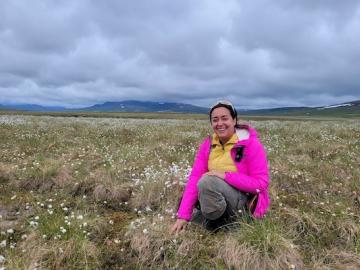
Filter News
Area of Research
- (-) Biology and Environment (44)
- (-) Clean Energy (78)
- Advanced Manufacturing (1)
- Chemistry and Physics at Interfaces (1)
- Data (1)
- Energy Frontier Research Centers (1)
- Functional Materials for Energy (1)
- Fusion and Fission (7)
- Isotope Development and Production (1)
- Isotopes (9)
- Materials (34)
- Materials Synthesis from Atoms to Systems (1)
- Materials Under Extremes (1)
- National Security (16)
- Neutron Science (8)
- Nuclear Science and Technology (5)
- Renewable Energy (1)
- Sensors and Controls (1)
- Supercomputing (9)
News Type
News Topics
- 3-D Printing/Advanced Manufacturing (10)
- Big Data (2)
- Bioenergy (12)
- Biology (18)
- Biomedical (5)
- Biotechnology (2)
- Buildings (6)
- Chemical Sciences (3)
- Clean Water (5)
- Climate Change (8)
- Composites (1)
- Computer Science (3)
- Coronavirus (6)
- Critical Materials (1)
- Cybersecurity (2)
- Decarbonization (12)
- Energy Storage (12)
- Environment (29)
- Exascale Computing (1)
- Grid (6)
- High-Performance Computing (5)
- Hydropower (2)
- Machine Learning (1)
- Materials (3)
- Materials Science (3)
- Mathematics (3)
- Mercury (4)
- Microscopy (5)
- National Security (1)
- Net Zero (2)
- Neutron Science (1)
- Physics (1)
- Polymers (1)
- Security (2)
- Simulation (3)
- Summit (2)
- Sustainable Energy (12)
- Transportation (10)
Media Contacts

Materials scientist Denise Antunes da Silva researches ways to reduce concrete’s embodied carbon in the Sustainable Building Materials Laboratory at ORNL, a research space dedicated to studying environmentally friendly building materials. Credit: ORNL, U.S. Dept. of Energy

Tomás Rush began studying the mysteries of fungi in fifth grade and spent his college intern days tromping through forests, swamps and agricultural lands searching for signs of fungal plant pathogens causing disease on host plants.

With wildfires increasing in scope and intensity around the world, Fernanda Santos’ research into how such calamities affect soil carbon storage has taken on new urgency.

When Bill Partridge started working with industry partner Cummins in 1997, he was a postdoctoral researcher specializing in applied optical diagnostics and new to Oak Ridge National Laboratory.

Chemical and environmental engineer Samarthya Bhagia is focused on achieving carbon neutrality and a circular economy by designing new plant-based materials for a range of applications from energy storage devices and sensors to environmentally friendly bioplastics.

Mechanical engineer Marm Dixit’s work is all about getting electricity to flow efficiently from one end of a solid-state battery to the other. It’s a high-stakes problem

Science has taken Melanie Mayes from Tennessee to the tropics, studying some of the most important ecosystems in the world.

Jennifer Morrell-Falvey’s interest in visualizing the science behind natural processes was what drew her to ORNL in what she expected to be a short stint some 18 years ago.

What’s getting Jim Szybist fired up these days? It’s the opportunity to apply his years of alternative fuel combustion and thermodynamics research to the challenge of cleaning up the hard-to-decarbonize, heavy-duty mobility sector — from airplanes to locomotives to ships and massive farm combines.

When Andrew Sutton arrived at ORNL in late 2020, he knew the move would be significant in more ways than just a change in location.


